For better or for worse, for richer or poorer...
(Editor's Note: This article originally appeared in the April/May 2008 issue of Farm Equipment magazine.)
When Ken Wagner explains the genesis of moving 800 miles from his home in Michigan for a new business opportunity in Kansas, a lot had to do with the fact that his wife, Diane, hoped to one day return to the Kansas City area where she grew up. Wagner, who spent 13 years with John Deere as territory manager prior to joining wood-chipping manufacturer Morbark in Michigan, was ready to do something different when he heard from old friends at John Deere (including aftermarket manager and future partner Bill Kilgore) that a dealership in Ottawa, Kan., had been cancelled. Through Deere’s market research, a pin (representing a new dealership) was about to be placed in the map in Baldwin City, Kan., 45 miles from his wife’s hometown.
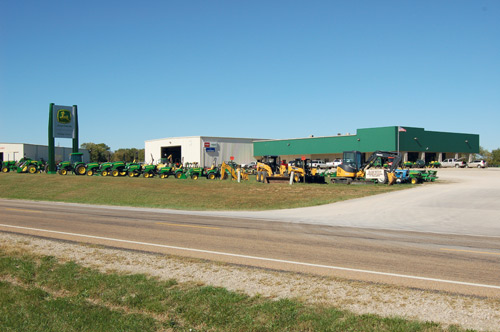
Starting with zero equipment, zero buildings and zero staff, this dealership has grown to five locations in two states — in just 10 years.
Wagner saw the opportunity in claiming the new dealership, particularly with the opportunity to balance the volatility of ag with the consumer-type business. People were rapidly fleeing the city for rural communities, and he thought the newer dealers could better serve this customer base than the ag-entrenched dealers.
“There was no complementary ag business here,” says Wagner. “There was a grain elevator and that was it — no retail hub nor any employee base. But they continued to convince me that this was the place to be to be, with the ag influence and close proximity to Kansas City, Lawrence and Ottawa — right in the middle of the triangle.”
Wagner bit on the opportunity. With no facilities that were close to what he wanted, he bought 17 acres on which he’d build a brand new facility, and packed his bags for Baldwin City.
Next Steps
Heritage Tractor, Inc.,
Baldwin City, Kan.
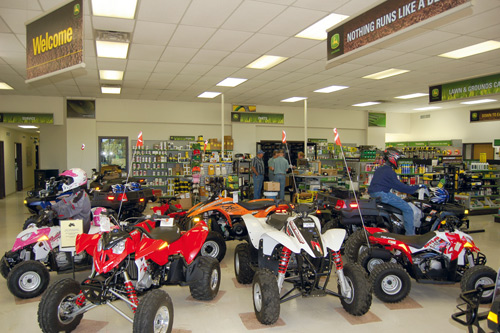
Founded: 1998
Locations: 5 (Baldwin City, Paola and Topeka, Kan., and Harrisonville and Clinton, Mo.)
Employees: 115
Major Line: John Deere
Shortlines: Land Pride, Polaris, Aluma, Lawn-Boy, Stihl, Kawasaki, Grain Bags
2007 Sales: $60 million
Key Staff: Ken Wagner, president; Derek Dummermuth, CFO; Greg Schwartz, sales.
His new company, which he would call Heritage Tractor, was at a disadvantage from most new businesses. With no equipment nor a place to work from, his first order of business was hiring Greg Schwartz, a salesman at the former Ottawa dealership who had 8 years of experience.
His contacts from his John Deere days helped line up his investors. He contacted a much-respected dealer he had called on years earlier, Richard Dummermuth, who had since exited the equipment business for a career in banking. The recipient of Wagner’s first call and the first to read his business plan, he promptly signed on as a 50% investor. The Wagners have a 39% interest, and Kilgore and his wife, Meg, represent the other 11%.
“We have good partners that understand the business — that’s critical,” Wagner says. “In 1997 when we were planning the business, the farm economy wasn’t the best. We had people who were capable of thinking long-term. This is not a business you can start up and make money the first year out — it takes several years to where you’re not losing money.”
Remembering the Early Days
Prior to Wagner inking a deal with John Deere for Baldwin City, there was much talk at the coffee shop about what was going to happen since the cancellation of the Ottawa store. Mainly, would anyone would be there to look after farmers’ investments in green equipment?
“We decided we could capitalize on buzz and get the word out to the community, to spin the news in our favor and let them know we were going to be there to do business. We were very well-received.”
With no facilities, there was no choice but to get out to the farms, something that may have been fortuitous in forming the new company. It fostered a new type of customer service and let everyone know that this was going to be a different type of dealer. The phone numbers left with customers were for Schwartz’ and Wagner’s homes — there was no office to call.
For a while, the headquarters was wherever Ken’s and Greg’s pickup trucks happened to be. Surprisingly, the pair sold $1 million from those “offices with steering wheels” — in the first month alone.
Soon, a series of trailers went up (first for an on office, then eventually another for parts storage). A farmer’s barn 3 miles down the road served as a temporary shop.
For 9 months while the building was going up, everything was run out of trailers in what Diane called a mini-trailer park.
Those early days were not without its challenges. Things like having to set up equipment outside and on rocky terrain (and in the presence of wildlife). Having no running water or temperature controls for 9 months. Trying to hold onto the chairs and items rolling off of desks due to trailers that were constantly settling into the ground. Without a truck or trailer, needing to drive every combine personally. Dealing with the communication issues of the parts and service operation that was 3 miles away. Constantly heading to Kansas City on parts runs. “Ken wore out a lot of tires on that route,” recalls Diane.
Wagner's Advice for Fellow Dealers
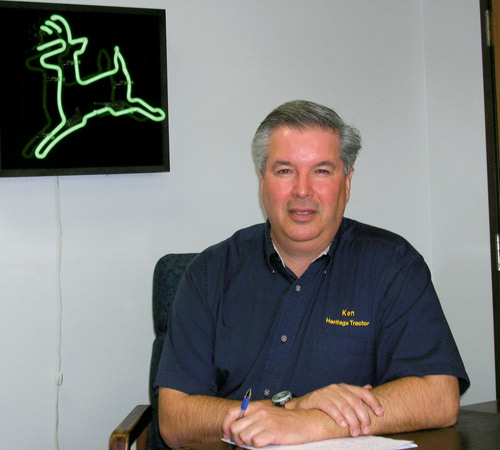
When asked for his advice to other dealers, Heritage Tractor’s Ken Wagner has 5 pieces of advice.
-
Surround yourself with a good corps of people.
-
Make sure you’re properly capitalized.
-
Don’t try to grow too big too fast.
-
Never forget who the customer is.
-
Reward the employees who are performing for you.
Those are the entrepreneur’s most trying, but often most rewarding, days — without the attitudes, bureaucracy, etc. It was all about “just doing it,” and there was no such thing as a job description.
In addition to the 16-hour days, there was also mental stress. “The first 3 years were tough,” says Wagner. “Building the facility and then looking at the P & L’s every month, we were losing money. By the time we finished building and moved in, the economy had slipped fast quickly. But we just kept plugging away.”
“Looking back, it was a character-building experience,” he says. “Not only for the organization, but the customers, too. Since we operated right on the land we were building on, they saw progress every day. They liked it and felt part of the deal.”
Looking for Something Different
Ken Wagner is always looking for something different and new to inject into his business. “For years, the industry was kind of close-minded to new ideas on run- ning a dealership. But customers are different today. They are big businessmen in their own right and won’t necessarily accept what their father did 25 years ago. We’re always looking for a way to differentiate from competitors by different marketing and product support concepts.”
Among his examples of being different was the Ready-to-Mow mobile services for residential customers (see feature article in the Spring 2008 Rural Lifestyle Dealer) that it helped get off the ground. Another is their aggressiveness in combine winter service, offering 100% machine warranty on units in the full inspection program. Yet another is its foray into real-time kinematics (RTK) subscription services for precision farming customers, as the firm now has three base stations to help customers capitalize on sub-inch accuracy.
Another out-of-the-box idea to bring more consumer traffic in his store is the sale of Purina feed from the Topeka store. “We’re selling 30 tons per month now to horse owners, who tend to have 2-3 horses on 20 acres. These are planned purchases they can come to our store for, and then see our lawn equipment, tractors and mate- rial handling units. It complements equipment sales to a core customer.”
Wagner says that the margins are about 25% and Purina believes the Topeka store can move 80 tons per month. “If we can achieve that, it’s a very nice profit center,” he says. “It’s just an example of stepping out, so to speak, complementing your business and diversifying.”
Schwartz explained that even if they were the new kid starting from ground zero, customers noticed the progress. “People want to do business where business is going on,” he says, drawing a parallel to a crowded church. “Selling is a momentum thing, and we got on and rode it.”
Wagner recalls the day when their first piece of stock equipment — a no-till drill — arrived. With nothing but a couple of trucks parked on the property, he and Schwartz watched a confused delivery truck driver pacing up and down the frontage road before they could flag him down and tell them they were indeed Heritage Tractor. Trying to convince the skeptical driver that they were legit, they shared how they’d even sold $1 million in the first month. Wagner recalls that the driver told them, “You guys outta quit right now.”
With no equipment to speak of, it took 3 hours and a call to local farmer with a tractor-loader to unload the drill off the truck, Wagner remembers.
Hiring: Energy Mattered
One thing Wagner attributes to getting through the early days was the company’s ability to find good people to climb aboard. This was no small feat, says Kilgore, giving full credit to Wagner. “It’s impressive when you start a business and get people who want to listen to you and trust you. At the time, we didn’t even have a delivery truck. We were going to be entrepreneurs, not bureaucrats.
“We had desire and we had energy. Ken hired people with energy, and it didn’t matter if they were just 18 or 20 years old. People are attracted by energy, which worked with attracting customers and employees.”
In addition to offering compensation that was better than what most were used to (even though it was deserved), Wagner said prospects could see a company building for growth. And also that it was going to be a clean environment with things like overhead bridge cranes to make work easier.
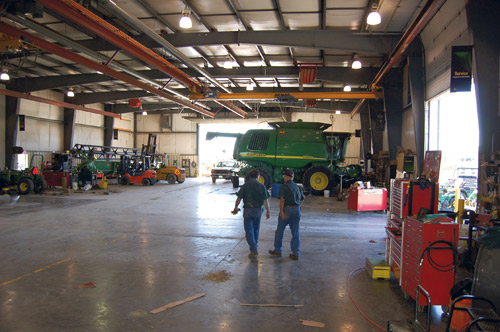
Both of the new facilities at Topeka and Baldwin City (pictured) have expansive shops. Radiant-heated floors and overhead cranes are among the investments to attract technicians.Within a 7-year-period, the firm spent $3.5 million constructing two new facilities.
“We recognized that we needed to do what we could to make techs more efficient, with less workers’ compensation issues and improving their longevity,” says Wagner. The decisions to invest in oil delivery to the work bay areas, great lighting and in-floor radiant heat were wise ones, as they all helped Heritage Tractor fill the important profit-generating service tech positions early on.
Dummermuth notes that the firm grew its volume faster than expected, primarily because the company had no other choice but to be customer-focused from its very first day. And the community responded with great support for what Heritage was trying to do. Plus, because of its meager beginnings, it naturally created a culture of employees thinking for themselves.
“We’ve seen other dealerships where the decisionmaking is militaristic, that there’s a hierarchy to follow,” says Dummermuth. “Some struggle when that leash is taken off. From day one, people here had a lot of autonomy to make decisions and do the job,” he says.
Growth … & Growing Pains
Words of Wisdom
Farm Equipment collected additional advice from Diane Wagner and Derek Dummermuth based on the firm’s first 10 years in business.
Develop Future Managers. “When you’re in the acquiring mode, you need to be constantly grooming managers, which is difficult because you don’t want to be stretching payroll too early,” says Derek Dummermuth, CFO. “You need people who know the culture, can lead and assimilate and get others to follow.”
Heritage hired a manager in anticipating of an acquisition that later fell through, yet kept him in a sales capacity for 9 months. “It was the best thing for him and for us, since he learned the culture and how we did business for that period of time.”
He also cautions management to resist the urge to do too much itself. “You need key people you can trust. You can only do so much when you’re only at the store a couple times a week.” Heritage finds it wiser to move suc- cessful managers from established stores than to bring someone else into a new situation.
Learn from Other Stores, Too. Despite the cultural issues common when integrating stores, Diane Wagner advises resisting the notion that the acquired store does everything wrong. Specifically, Heritage has incorporated concepts from acquired stores, like business and paperwork procedures and aftermarket marketing concepts.
Little Things Matter. Dummermuth notes that in the 2 years following the Topeka acquisition, Heritage boosted market share from 9% to 30%. “We did it by working on relationships, doing customer clinics and even paying attention to little things like sending birthday cards, etc. These things are a way to stand out from other deal- ers while building a long-term relationship that shows we’re not just in it to sell a machine.”
While the company was still getting used to the smell of fresh paint in its 32,000 square foot, $1.2-million dollar facility, the dealership soon would embark on yet another journey.
Acquisitions were not in the original business plan, says Wagner. “We never thought 10 years later that we’d be doing $60 million with 5 locations.
“When we put the business together, Deere was not encouraging multi-store locations. About 5 years ago, that philosophy changed to encourage ownership groups that were growth-oriented to expand in multiple locations. I don’t think anyone saw that coming.”
The firm’s first expansion, acquiring a location in Paola in 2002, was a small one. The firm built onto a convenience store and steadily grew the operation from a four-employee operation to a 10-person one today. “There was an advantage of the first expansion being a small one because mistakes weren’t costly,” says Wagner.
The third location came 3 years later, when Heritage decided to build new again in Topeka. “We bought out a dealer in nontraditional way,” Wagner explains. “We didn’t want the assets or facility so we negotiated a contract in which he would terminate his agreement with Deere. The only asset we took was one employee. We basically started over. We rented a temporary facility, hired a store manager and built a brand new organization just like Baldwin City.”
The result was a brand new $2.4 million, 36,000-square-foot facility, which incorporated additional lessons learned after several years in the Baldwin City operation. With the help of greater use of Stanley Vidmar parts cabinets, a much larger showroom was built, along with twice as many overhead cranes in the larger shop and a warehouse that was connected to the main building.
When asked if he’d do it again, he nods, as long as the situation is right. “It can be a positive when you start with a clean sheet of paper. Sometimes when you acquire an ongoing business, you end up buying issues.”
In February of 2007, the firm acquired two stores across the state line in Harrisonville and Clinton, Mo., which brought a new set of challenges. Not only in doubling the size of the company, but also merging two diverse cultures — including what had previously been the fiercest of competitors.
In explaining the challenges with integrating Kansas and Missouri stores, Diane also referenced the natural rivalry between the states, which included one of the Civil War’s earliest battles near Baldwin City.
“When the owner retired and we acquired the stores, those who had been in the trenches fighting with us for the retail business were Heritage Tractor employees overnight,” says Wagner.
In Support of Deere’s Business Model
While Deere’s edict of large, multi-store dealerships hasn’t met all customers’ approval, Heritage Tractor believes the concept is on-target because the margins in the farm equipment business are low relative to other retail industries. “If dealers are to be in business over the long term with sustainable profits, a certain size and scope of business is needed to make it work,” says Ken Wagner, president.
“With a larger scale and scope, you can have the cash flow to afford good people. On AMS side, where it’s very technically oriented, we wouldn’t have been able to afford the support staff for it 10 years ago. But now, we can spread those assets throughout the organization, and leverage them.”
The same concept is true, says Wagner, with regard to computers, vehicles, service tools and other assets that use valuable cash. “Think of individual dealerships and their mobile delivery trucks. Instead of each individual dealership having a $150,000 vehicle, a 5-store operation might be able to get by with two trucks. That’s a tremendous economy of scale advantage for a multi-store group.”
Dummermuth, who says that Deere’s target of 3-6 stores and sales of $50 million is moving fast to 8-10 stores with $100 million, agrees that it’s a better business model. “We can better invest in inventory, infrastructure, things like AMS that would’ve been hard to do with 1-2 stores. We’re a better dealer and more successful now that we’re on a bigger scale.”
Like many dealers, Heritage Tractor tried to make things work. But like most dealers who’ve acquired other stores, tough decisions eventually had to be made. When asked what he’d do differently today, he says, “If your gut tells you need to make personnel changes, it’s better to do it right off the bat vs. thinking you can change people or practices and get buy-in. We tried to mold the cultures together. For the sake of the employees and ourselves, we should have said here’s how it is, and figured out who was going to be part of it and who wasn’t.”
What’s Next?
When asked what’s next for Heritage Tractor, Wagner says they’ll continue to grow, but likely not at pace of last 4 years. “We’re going to fine-tune things before we seek out new opportunities, unless something presents itself with another ownership group.”
Practically, he thinks Heritage could grow to three additional locations. “The bogey keeps moving, but it seems that in today’s dollars, Deere will be looking for $80-85 million sales volume area.”
The biggest challenges moving forward, he says, are continuing to hire good people and properly capitalize the growth and expansions. He feels confident on both fronts, however, in part because of the succession plans in place.

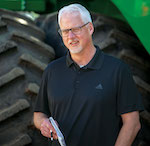



Post a comment
Report Abusive Comment